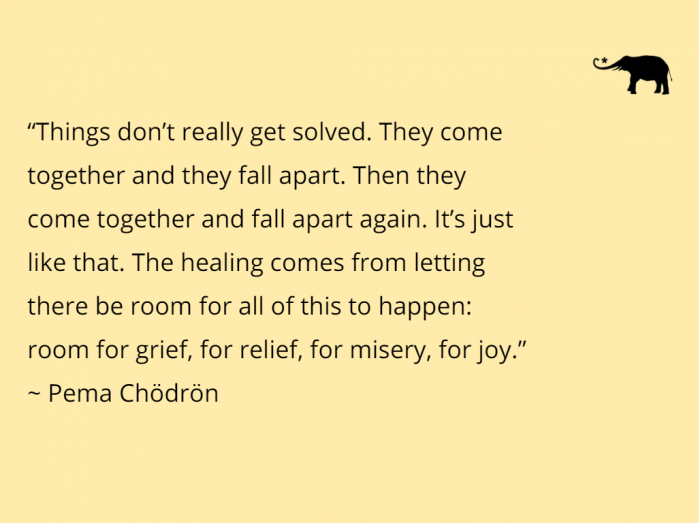
*Slightly salty language ahead.
~
I gently blow over the top of my steaming coffee cup, my friend sits opposite watching me intently.
Our eyes meet, mine slightly watery, a remnant of an intense conversation we have just had for the umpteenth time, the one where I explain how despite the time passed, my pain still lingers. As I sit with my heart beating on my shoulder, my mind ruminating over its permeating scar and my head heavy with unsettled grief, she places her hand on mine, holds my gaze, and says defiantly, yet gently, “you gotta let it go now.”
Let it go. It’s as easy as that right? I mean shit—why didn’t I think of that!?
As I continue with the rest of my day, her well-meaning summation of my months of grieving hurts more than it heals. The ease in which those words flowed out of her mouth as if it were the most natural thing in the world, the whimsical notion of throwing sails to the wind and floating away my pain across the seas, toward the Island of Forgotten Love is a notion that seems more foreign to me than I can handle. To add to this already shitshow of a day I also have that god-awful song from Disney’s Frozen ringing through my ears, Letttttt it goooooo, let it go. Arghhhh.
For days after, I pondered her comment and why I felt so triggered by it.
Firstly, I felt like it was a personal attack. As if the premise of her advice was to chastise me somehow. Why hadn’t I let it go yet? What was wrong with me? Why was I holding onto this pain? Is this feeling all my fault? I was weak and pathetic.
Secondly, I felt like it did not, in anyway, acknowledge my pain. Instead, her “fix it” approach burdened me with even more shame. Shame for still being upset and shame for not being strong enough to walk away from it.
And thirdly, I felt as if she had applied an invisible timeline to my pain. It’s been a year now…surely that’s enough empathy…surely you can’t still be whining on about this same shit. What’s wrong with you? It’s as if she had hit the button on the stopwatch and deemed my heartbreak as breaching the acceptable-time-allowed-to-be-upset barrier.
Let it go comes in many different guises too. How many times have we been “gifted” with this wisdom from our loved ones? I might also sound like, “forgive and forget,” “stop living in the past,” “move on,” “close the door,” etcetera, ad nauseam. It’s a relentless barrage of ignorance cloaked in good intention that we frankly do not need. Not only is this bullshit advice it’s also bad advice.
When we tell people to let it go, we are inadvertently dismissing their pain. And that is never the right course of action. Letting go, moving on, getting over it is a process—and even at the end of that, we still may not be ready to let it go completely. And that is okay.
What the positive police in our lives fail to acknowledge when they tell us to let it go, is that we all tap into a coping process when we feel acute loss or pain. The most widely documented one being the DABDA response, which encompasses the following stages: Denial, Anger, Bargaining, Depression, and Acceptance. Also known as the stages of grief, this model is one which applies to all sorts of pain. Be it heartbreak, loss, betrayal, illness, or any other form of life-changing event, we must work through these stages to finally “let it go.”
In fact, what we need to do is let these feelings in, not let the feelings go, to be able to reach acceptance.
By letting in and going through these stages, we are getting closer to getting through this experience. We are doing the work; we are gaining all the valuable insight and learning that comes with experiencing pain. That is being human. That is going to give us long-term peace.
Letting things go prematurely, without allowing ourselves to live and breathe in our feelings and emotions will stunt our growth, reduce our capacity to cope, and increase the longevity of the pain we feel.
Whilst these are defined stages, they are not in anyway attached to a specific timeline. That timeline is of our making, and we will work through it in our own time, regardless of if that takes weeks, months, or even years.
The shitty truth about painful emotions and traumatic experiences is that you can’t just “let them go.” If you force it, you will fail and end up feeling worse due to that failure (just to add fuel to the fire).
And when you do finally let it go, it is only because you allowed yourself to go through the process and express your sadness, anger, or pain, loudly and clearly. This point, once reached, is the time where you finally understand, acknowledge what you’re going through, and then you decide to move forward.
You don’t need strength to let go of something. What you really need is understanding. ~ Guy Finley
~

A lot of interesting thoughts here. When I try to force my emotions away or fix the problem, they resurface again and again until they’re heard.
I hear “let it go” and “let the feelings in” as one in the same. In order to let them in, I need to let go of my resistance to them. Regardless of the intent of the advice giver, it’s one way of hearing it.
Reply